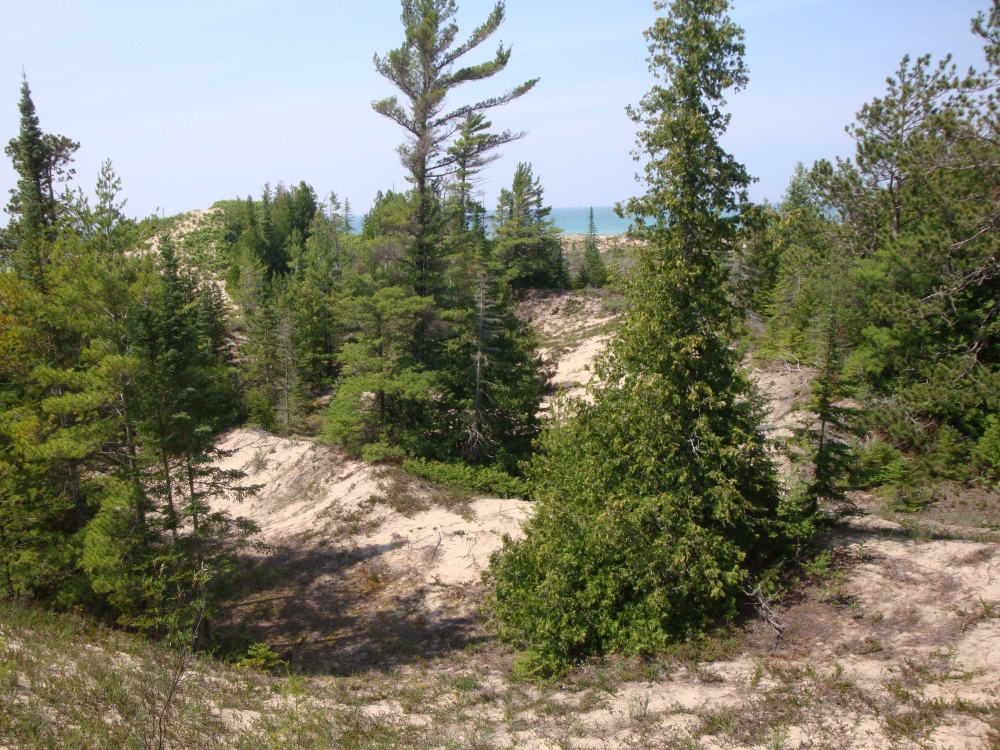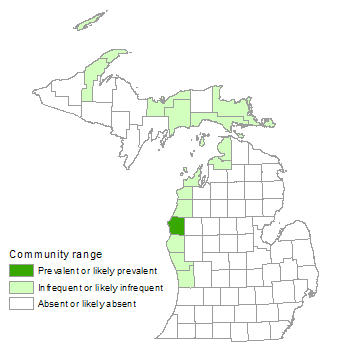Overview
Great Lakes barrens is a coniferous savanna community of scattered and clumped trees, and an often dense, low or creeping shrub layer. The community occurs along the shores of the Great Lakes where it is often associated with interdunal wetland and open dune.
Rank
Global Rank: G3 - Vulnerable
State Rank: S2 - Imperiled

Landscape Context
Great Lakes barrens occur on sandy former lake embayments along Great Lakes shorelines. They may occur in dune fields and in depressions between dune ridges within open dunes and may grade to interdunal wetlands where depressions are in contact with underlying groundwater. The surrounding landscape is typically forested, with the dune sands supporting a variety of forest types depending on slope, aspect, and geographic location.
Soils
The sand soils are circumneutral and dry. Subsoil water levels in depressions are periodically elevated by changes in Great Lakes water levels.
Natural Processes
This woodland community develops on dune fields and in protected depressions between dunes, where sand is stable enough to allow trees to establish and mature. However, periodic episodes of sand movement and vegetation burial do occur between dune ridges. The prevalence of jack pine is probably the result of extreme growing-season frosts within the low depressions, which kill most other woody species. Tree mortality also occasionally occurs when Great Lakes water levels rise, causing an increase in water levels within the low interdunal depressions and flooding of trees. Prolonged periods of flooding can result in the establishment of wetland vegetation and formation of interdunal wetlands. Open, dry conditions allow jack pine to establish rapidly when water levels drop.
Vegetation
The most dominant tree species of the open canopy is jack pine (Pinus banksiana), followed by white pine (P. strobus). Other trees of the scattered canopy of Great Lakes barrens include red pine (P. resinosa), white spruce (Picea glauca), cottonwood (Populus deltoides), balsam poplar (P. balsamifera), and paper birch (Betula papyrifera). The low shrub layer is well represented because of the open canopy, with dense common juniper (Juniperus communis) and bearberry (Arctostaphylos uva-ursi) most common, followed by creeping juniper (J. horizontalis), beach heath (Hudsonia tomentosa), poison ivy (Toxicodendron rydbergii), sand cherry (Prunus pumila), and soapberry (Shepherdia canadensis). Dune grasses are prevalent in the ground layer, especially marram grass (Ammophila breviligulata), sand reed grass (Calamovilfa longifolia), and little bluestem (Schizachyrium scoparium). Other characteristic grasses include poverty grass (Danthonia spicata), fescue (Festuca saximontana), June grass (Koeleria macrantha), hair grass (Avenella flexuosa), wheat grass (Elymus lanceolatus), and slender wheat grass (E. trachycaulus). Wormwood (Artemisia campestris), starry false Solomon’s seal (Maianthemum stellatum), and plains puccoon (Lithospermum caroliniense) are the most common forbs. Other species of stable sandy habitats and open dunes are typically present, including rough sand sedge (Cyperus schweinitzii), cudweeds (Pseudognaphalium spp.), and cow-wheat (Melampyrum lineare). Moss and lichen cover is typically partial. Commonly occurring species include Tortula tortuosa, Leucobryum glaucum, Cladina rangiferina, and British soldiers (Cladonia cristatella).
For information about plant species, visit the Michigan Flora website.
Plant Lists
Graminoids
- marram grass (Ammophila breviligulata)
- wavy hair grass (Avenella flexuosa)
- sand reed grass (Calamovilfa longifolia)
- ebony sedge (Carex eburnea)
- rough sand sedge (Cyperus schweinitzii)
- poverty grass (Danthonia spicata)
- wheat grass (Elymus lanceolatus)
- slender wheat grass (Elymus trachycaulus)
- Rocky Mountain fescue (Festuca saximontana)
- June grass (Koeleria macrantha)
- rough-leaved rice-grass (Oryzopsis asperifolia)
- switch grass (Panicum virgatum)
- little bluestem (Schizachyrium scoparium)
Forbs
- wormwood (Artemisia campestris)
- common milkweed (Asclepias syriaca)
- harebell (Campanula rotundifolia)
- lance-leaved coreopsis (Coreopsis lanceolata)
- wild strawberry (Fragaria virginiana)
- hairy bedstraw (Galium pilosum)
- plains puccoon (Lithospermum caroliniense)
- Canada mayflower (Maianthemum canadense)
- starry false Solomon-seal (Maianthemum stellatum)
- cow-wheat (Melampyrum lineare)
- rock sandwort (Minuartia michauxii)
- horse mint (Monarda punctata)
- clammy cudweed (Pseudognaphalium macounii)
- smooth aster (Symphyotrichum laeve)
Lichens
- reindeer lichens (Cladina mitis and C. rangiferina)
- British soldiers lichen (Cladonia cristatella)
Mosses
- Leucobryum moss (Leucobryum glaucum)
- tortured tortella moss (Tortella tortuosa)
Woody Vines
- poison-ivy (Toxicodendron radicans)
- riverbank grape (Vitis riparia)
Shrubs
- bearberry (Arctostaphylos uva-ursi)
- pipsissewa (Chimaphila umbellata)
- beach heath (Hudsonia tomentosa)
- common juniper (Juniperus communis)
- creeping juniper (Juniperus horizontalis)
- sand cherry (Prunus pumila)
- soapberry (Shepherdia canadensis)
- poison-ivy (Toxicodendron rydbergii)
Trees
- paper birch (Betula papyrifera)
- white spruce (Picea glauca)
- jack pine (Pinus banksiana)
- red pine (Pinus resinosa)
- white pine (Pinus strobus)
- balsam poplar (Populus balsamifera)
- cottonwood (Populus deltoides)
- red oak (Quercus rubra)
- northern white-cedar (Thuja occidentalis)
Noteworthy Animals
Conditions in barrens are similar to those of open dunes, where animals are adapted to extreme surface temperatures, which regularly reach 120o F (50o C) or more. To survive, dune inhabitants like Fowler’s toad (Bufo fowleri), eastern hognose snake (Heterodon platyrhinos), spider wasps (Family Pompilidae), and wolf spiders (Family Lycosidae) burrow down to reach cooler temperatures and are active at the surface only from evening to morning, when the temperatures are lower. Antlions (Family Myrmeleontidae) have adapted to the environment by building funnel-shaped sand traps where insects and ants become trapped.
Rare Plants
- Botrychium acuminatum (acute-leaved moonwort, state endangered)
- Botrychium campestre (prairie moonwort, state threatened)
- Botrychium hesperium (Western moonwort, state threatened)
- Cirsium pitcheri (Pitcher’s thistle, federal/state threatened)
- Orobanche fasciculata (clustered broom-rape, state threatened)
- Pterospora andromedea (pine-drops, state threatened)
Rare Animals
- Dendroica discolor (prairie warbler, state endangered)
- Falco columbarius (merlin, state threatened)
- Trimerotropis huroniana (Lake Huron locust, state threatened)
Biodiversity Management Considerations
Off-road vehicles result in sand destabilization, which can bury the trees and other vegetation of Great Lakes barrens and the herbaceous or shrub vegetation of adjacent interdunal wetlands. Eliminating illegal off-road vehicle activity is a primary means of protecting the ecological integrity of Great Lakes barrens and associated shoreline communities. Invasive plants such as spotted knapweed (Centaurea stoebe), baby’s breath (Gypsophila paniculata), common St. John’s-wort (Hypericum perforatum), and common mullein (Verbascum thapsus) can stabilize vegetation and result in the loss of dune plants that rely on shifting sand, thereby facilitating the conversion to closed-canopy forest. Monitoring and control efforts to detect and remove invasive species are critical to the long-term viability of Great Lakes barrens.
Variation
Where the community occurs as part of a complex of open dunes, Great Lakes barrens typically dominate the drier depressions between dune ridges, while interdunal wetlands occupy the wet depressions.
Similar Natural Communities
Open dunes, interdunal wetland, pine barrens, and oak-pine barrens.
Places to Visit
- Cathead Bay, Leelanau State Park, Leelanau Co.
- Nordhouse Dunes, Ludington State Park and Manistee National Forest, Mason Co.
- Platte Bay, Sleeping Bear Dunes National Lakeshore, Benzie Co.
- Sturgeon Bay, Wilderness State Park, Emmett Co.
Relevant Literature
- Albert, D.A. 2000. Borne of the wind: An introduction to the ecology of Michigan sand dunes. Michigan Natural Features Inventory, Lansing, MI. 63 pp.
- Arbogast, A.F., and W.L. Loope. 1999. Maximum-limiting ages of Lake Michigan coastal dunes: Their correlation with Holocene lake level history. Journal of Great Lakes Research 25: 372-383.
- Cowles, H.C. 1899. The ecological relations of the vegetation on the sand dunes of Lake Michigan. Botanical Gazette 27(2): 95-117.
- Faber-Langendoen, D., ed. 2001. Plant communities of the Midwest: Classification in an ecological context. Association for Biodiversity Information, Arlington, VA. 61 pp. + appendix (705 pp.).
- Lichtner, J. 1998. Primary succession and forest development on coastal Lake Michigan sand dunes. Ecological Monographs 68: 487-510.
- Olson, J. 1958. Rates of succession and soil changes on southern Lake Michigan sand dunes. Botanical Gazette 119: 125-170.
- Thompson, T.A. 1992. Beach-ridge development and lake-level variation in southern Lake Michigan. Sedimentary Geology 80: 305-318.
Citation
Cohen, J.G., M.A. Kost, B.S. Slaughter, D.A. Albert, J.M. Lincoln, A.P. Kortenhoven, C.M. Wilton, H.D. Enander, and K.M. Korroch. 2020. Michigan Natural Community Classification [web application]. Michigan Natural Features Inventory, Michigan State University Extension, Lansing, Michigan. Available https://mnfi.anr.msu.edu/communities/classification. (Accessed: December 27, 2025).
Kost, M.A., D.A. Albert, J.G. Cohen, B.S. Slaughter, R.K. Schillo, C.R. Weber, and K.A. Chapman. 2007. Natural Communities of Michigan: Classification and Description. Michigan Natural Features Inventory, Report No. 2007-21, Lansing, MI.


